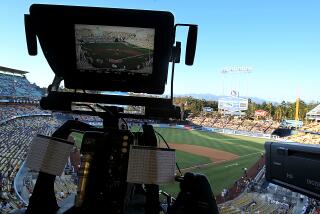If 75 Cable-TV Channels Just Aren’t Enough, Try 150 . . . : Television: Cable diversification follows the magazine trend of specializing. And, while pay per view may be costlier, the basic rate may not go up.
In an ordinary residential neighborhood in Queens, N.Y., the future of cable television will officially go on-line Wednesday morning. That’s when the Time Warner New York City Cable Group will hook up the first subscriber to receive the nation’s only 150-channel cable-TV system.
“It’s safe to say that this event is going to signal a new chapter in cable-television history,” said National Cable Television Assn. spokeswoman Peggy Laramie.
At present, the average cable-TV home in America is capable of receiving about 35 channels, according to the U.S. General Accounting Office. Cable industry leaders say that, for many cable systems, that number could swell to 100 to 150 channels within two years, thanks to advances in fiber optics and digitally compressed TV signals.
If you’re wondering at this point: “One-hundred-and-fifty channels of what? “ or “How much is this going to cost me?,” the Time Warner system, which is starting out slowly with 10,000 subscribers in two neighborhoods, is a model of what’s in store for the rest of the country.
The system’s existing 75 channels of standard and premium services will remain virtually intact. Fifty-seven added channels will be devoted to the Time Warner Home Theater, consisting entirely of pay-per-view programming. The remaining 18 new channels will be reserved for satellite programming services and interactive telecommunications tests, such as mini-cellular telephone service, teleconferencing, computer networks, FAX machines, electronic banking and, as the technology develops, high-definition TV broadcasts.
The cost to run the hybrid system of fiber optics and coaxial cable into a neighborhood is about $150 to $200 per subscriber, said Jim Duffy, spokesman for American Television and Communications, a Time Warner unit.
Time Warner, however, will not raise its standard cable rate of $22.95 and will only charge higher fees to subscribers who order pay-per-view shows.
“What we want to do eventually is have Chinese restaurant menu ordering,” Duffy said. “In other words, a cable subscriber might say, ‘I want two of the three network affiliates, CNN and ESPN, and that’s all.’ ”
Cable industry sources agree that as these multichannel systems spread, a restructuring of the cable-TV subscription service will be in order.
“When you look at our nation’s present cable-TV model, with basic and premium cable services, what you really have are channels that have to cater to a broad, middle-of-the-road audience in order to be successful,” said Dick Green, president of CableLabs Inc. in Boulder, Colo., an industry consortium devoted to the development of technology for the cable industry.
“Now the movement in cable is toward more diversification, similar to what happened to the print industry,” Green said. “More specialized services are being created in which you have a revenue stream coming from the subscriber and the advertiser. The narrower the interest, the more costly the subscription fee. It’s the same process that magazines went through.”
Channel-capacity expansion won’t come a moment too soon for the newer cable networks fighting for a foothold in the overcrowded cable marketplace. Such upstarts as Courtroom Television Network, Country Music Television and the Monitor Channel, a Christian Science Monitor offshoot, are largely being locked out because there is no room. Cable operators are reluctant to drop current channels, they say, because that often leads to viewer revolts.
“On the average system, all but one or two channels are spoken for,” Laramie said. “New program networks--the Sci-Fi Channel and the Cowboy Channel--are competing to get on cable systems that are pretty well booked up.”
In anticipation of a larger cable universe, most established cable networks are developing or testing plans to spin off into new channels or to “multiplex” their programming on more than one channel. ESPN is researching a separate sports news network. Turner Broadcasting, which recently acquired Hanna-Barbera, is talking about an animated children’s channel. And the home-shopping network QVC envisions a TV shopping galleria, where viewers can enter a new store with each channel.
In an effort to help retain subscribers tired of paying for a high-ticket movie channel, HBO will multiplex HBO and sister station Cinemax on the new 150-channel Time Warner system. Viewers in Queens, for the regular HBO price, will receive HBO, HBO 2 and HBO 3--offering the same programming at different starting times.
“We’re shoring up and making pay television more valuable in anticipation of 150 channels of television,” said Betsy Bruce, vice president of field marketing for HBO. “I mean, how do you cut through that many channels? People pay an average of $10 for HBO. With multiplexing, we’re giving them a package of channels, in essence. The benefit to subscribers is more choice at any time.”
Executives at HBO believe that the investment in updating their control studios and hiring additional people to operate three channels will be paid for by improved subscriber retention.
In fact, most of the cable industry claims to be keeping cost containment in mind in building their bigger mousetraps, aware that subscribers have complained about rising rates since the Cable Act of 1984 took rate-setting away from local government.
“Our pattern in the past has been to add new services to basic cable and raise the rate,” said Bob Thompson, senior vice president of Tele-Communications Inc., which serves 9 million cable subscribers nationwide. “We want to get away from that. When channel capacity opens up everywhere, we’re predicting that basic cable will sell for the inflation-adjusted rate of $20. Everything else beyond that will be optional.”
The option that the industry seems most excited about right now is pay-per-view. With 57 channels, Time Warner Home Theater will be able to run its top movies every half hour, instead of once or twice a day, with prices ranging from $1.95 to $4.95.
“It’s like a cineplex theater, where the same hit movie plays over and over again,” said Marty Lafferty, vice president of Olympics Pay Per View, who is responsible for NBC and CableVision’s pay-per-view “triplecast” of the summer Olympics.
“With that many channels dedicated to pay per view, you could play every single title in the largest video store in the country in one week. It’s very consumer friendly, because if you don’t want it you don’t pay for it. And you could present special pay-per-view events like the Olympics or boxing without scrambling for space.”
More to Read
The biggest entertainment stories
Get our big stories about Hollywood, film, television, music, arts, culture and more right in your inbox as soon as they publish.
You may occasionally receive promotional content from the Los Angeles Times.










